Life in Istanbul Photography - M1key - Michal Huniewicz

"Western observers love to identify the things that make Istanbul exotic, non-Western, whereas the Westernisers amongst us
register all the same things as obstacles to be erased from the face of the city as fast as possible" - Orhan Pamuk,
Istanbul. Memories of a City.
The Turkish writer describes the anxiety that accompanies the residents of Istanbul whenever their city is portrayed by Westerners,
and how much their opinion matters to them - however inaccurate or ignorant it might be. As if to confirm that, on our departure we
were asked to fill in a lengthy survey with detailed questions about our stay and our impression of Istanbul, whether we would come
back, and whether we would recommend the city to our friends and family.
I visited Istanbul in late August 2011 with a group of friends to find sunlight and to relax, but also to try to find the answer
to the question preoccupying Istanbullus' minds: is this a European city we are talking about, or an Asian one? A Western one or
an Eastern one?
With my camera I attempted to capture the city and its struggle to define its identity. Founded in ancient times, once a melting pot,
but then having lost its cosmopolity, torn between East and West, Europe and Asia, Istanbul, like the rest of Turkey, is rapidly
Westernising, but also, and maybe most of all, seeking its own way after receiving a rather cold welcome on its EU accession process.
Turkey is proud of its Ottoman past; they love to boast about past achievements and never lose an opportunity to do so, hoping to
impress a foreign visitor.
One can easily sense this pride, but the omnipresent displays of nationalism made me feel somewhat uncomfortable.
Countless Turkish flags, big and small, army advertisements along the highways, military vessels majestically sailing back and forth,
overwhelming constructions, and pretty heavily armed soldiers and policemen remind us that we're visiting a country with huge
ambitions and aspirations.
Take a look at the pictures and get a taste of the only city in the world located on two continents - Istanbul.
This gallery shows a bit of Instabullus' lives.
Shooting range
Shooting range

Turkish boys entertain themselves shooting bottles with airsoft guns, against the old Valens aqueduct. According to the official
discourse in Turkey, Children's Day originated in their country.
Playing in the street
Playing in the street

This picture was taken after the last day of Ramadan. Children were playing in the streets, often with fireworks. They were very friendly,
asking for our names, laughing, and screaming to us.
Turkey offers free education through age of 14 - it's also compulsory. According to the UN however, in some regions of the country over
50 percent of girls between 6 and 14 years old did not attend school.
Night trade
Night trade
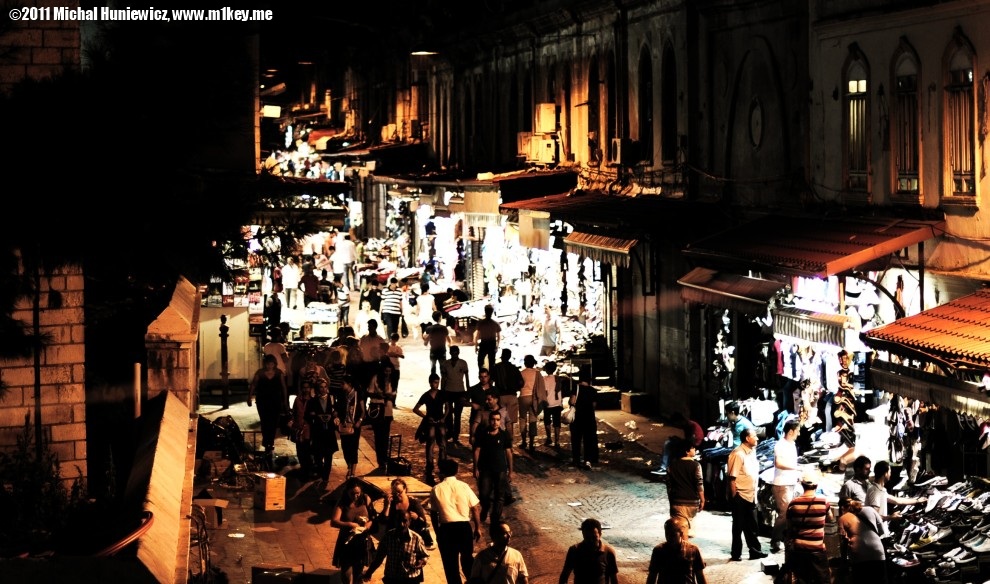
This is a small street in the Eminönü neighbourhood, swarming with people checking out whatever is on sale. Notice air conditioning installed
on almost every building. Winters however can be very cold, and Turkey is one of the world's top countries producing geothermal heating.
Fatih
Fatih

The charming and spiritual Fatih neighbourhood, with many mosques, but also churches and synagogues, is not visited by tourists
very often, and the locals tend to be more friendly and honest.
The average summer temperature in Istanbul is 28C (82F), the highest recorded 45C (113F).
Boys will be boys
Boys will be boys

The woman on the right looks a bit uncertain. So were we, and we surrendered to those boys, aiming at us with their toy guns.
Then we turned around and began to walk away, when my friend got shot in the back with a plastic bullet.
Fishing in the Golden Horn
Fishing in the Golden Horn

Men fishing in the Golden Horn, on the Galata Bridge. They stay there until very late and sometimes sell their catch
to other men grilling it and selling in bread, with onion and tomatoes.
The Süleymaniye Mosque seen in the background.
In the night
In the night

Bars next to the Galata Bridge, on the Western side.
Feeding birds
Feeding birds

People feeding birds near the Eyüp Sultan Mosque. The smell of those birds cannot be described and you're lucky
we don't have the technology to capture smells yet.
Boys posing
Boys posing

Inside the Eyüp Sultan Mosque courtyard. You can see how busy inner mosque courtyards are. People come there to
meet, talk and rest, not just pray.
Outside mosque
Outside mosque

Outside the New Mosque. Notice the camera on the right.
Inside the Blue Mosque
Inside the Blue Mosque

This picture was taken inside the Blue Mosque. The barrier you can see divides the mosque into a prayer space for
men and the tourist zone. Some believers prayed in the tourist zone as well. On the left hand side, you can see
men gathering for the prayer. The girl on the right had her pictures taken and is now going through them.
Most mosques have such a barrier, but not every single one and sometimes you can go and see the mihrab and minbar.
Mosque courtyard
Mosque courtyard

The New Mosque courtyard is throbbing with life. If you walk through the gate visible at the far end, you'll see the Golden Horn.
Mosque courtyard
Mosque courtyard

Entrance to the New Mosque.
Inside a mosque
Inside a mosque

Women in the New Mosque. The bags on the left are for the shoes. You don't have to carry them around, you can
leave them in a drawer or locker or on a simple shelf in the back. Children enjoy the soft carpet and often run around
screaming.
Leaving the mosque
Leaving the mosque

People leaving the Mihirimah Sultan Mosque. The tent on the left is a female only exterior prayer space.
Notice the man sleeping on the right hand side of the picture.
Before entering a mosque, you must take your shoes off - there are signs on the floor in case you forget.
Leaving the mosque
Leaving the mosque

Here, people are seen putting their shoes back on, after leaving the Blue Mosque. They put plastic bags in the wooden
bin.
Busy street
Busy street
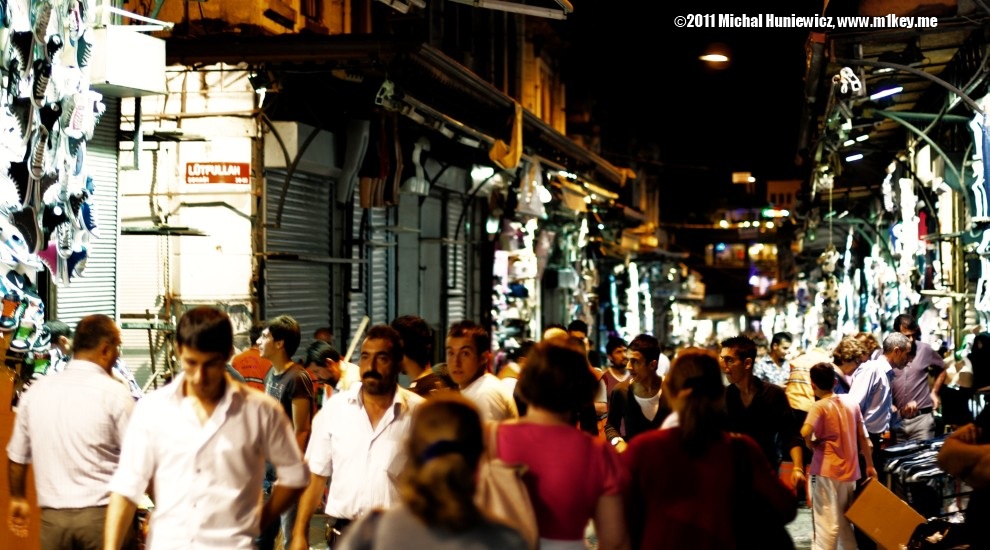
It's the same busy street from a few pictures before, seen from the other side.
Empty street
Empty street

And this is what the market streets look like after shops close. Desolate, lots of litter. Eminönü, near the Grand Bazaar.
Street like many other
Street like many other

A more modern version of the above. Countless shops with clothes, hotels, a mosque here and there.
Fishing in the Bosphorus
Fishing in the Bosphorus

These men are fishing on a little boulevard outside the Şemsipaşa Halk Kütüphanesi Mosque, on the Asian side.
Turkish women
Turkish women

The Ottoman Empire granted women certain rights - they could work as teachers, clerks, and industrial workers.
The Republic of Turkey brought women even more rights in the 20th century. For example, in 1934 they received both the right
to vote and be elected (Poland allowed women to vote in 1918, only days after regaining independence; Japan in 1945; Kuwait in 2005).
Western dress style prevails; some women however (around 30% depending on the source) still choose to wear a scarf (tesettür)
covering their heads. The veil is actually banned in Turkey - but the law is not enforced often. Most women wearing a burka that you see
in Turkey are from foreign countries.
Women's section
Women's section

Although the Quran does not require gender separation in mosques, traditional rules lead to actual separation. Here, in the
Blue Mosque, women are behind a barrier and behind shoes. In the Grand Mosque in Mecca there are no segregation barriers,
but there are sections exclusively for women and children.
Women's section
Women's section

A sneak peek of the women's section.
Women studying Quran
Women studying Quran

These women are in front of the barrier. The shelves behind them are for shoes. This picture was taken in the Süleymaniye Mosque.
In the evening
In the evening
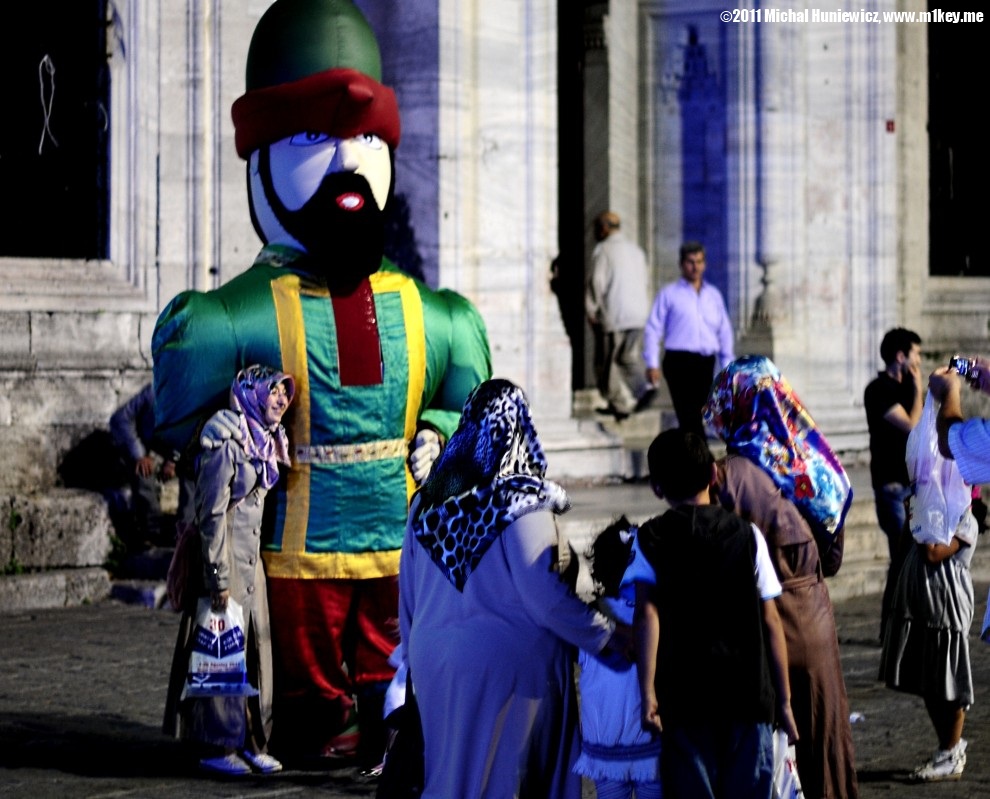
A Turkish woman has her picture taken with a mascot, possibly a Janissary one. Janissaries were infantry units of the Ottoman era.
Spice Bazaar
Spice Bazaar

This is one of the oldest bazaars in Istanbul. It's the centre of spice trade in Istanbul. This bazaar has a wonderful smell
and a pretty unique atmosphere (unlike the Grand Bazaar). You can buy all sorts of spices, but also tea, coffee, sweets, dry fruits
and so on. The salespersons may play a little practical joke on you (I'm not telling what exactly).
Remember that you will pay extra for the privilege of buying there. Don't forget to bargain!
Lamps
Lamps

Lamps on sale on the Yeniçeriler Street (which possibly means Jannisary Street).
Grand Bazaar
Grand Bazaar

I really didn't like the Grand Bazaar - it was overcrowded and to me it offered nothing of value; just souvenirs,
spangles, jewellery and so on.
Spice Bazaar
Spice Bazaar

Here are some spices from the Spice Bazaar.
Grand Bazaar
Grand Bazaar
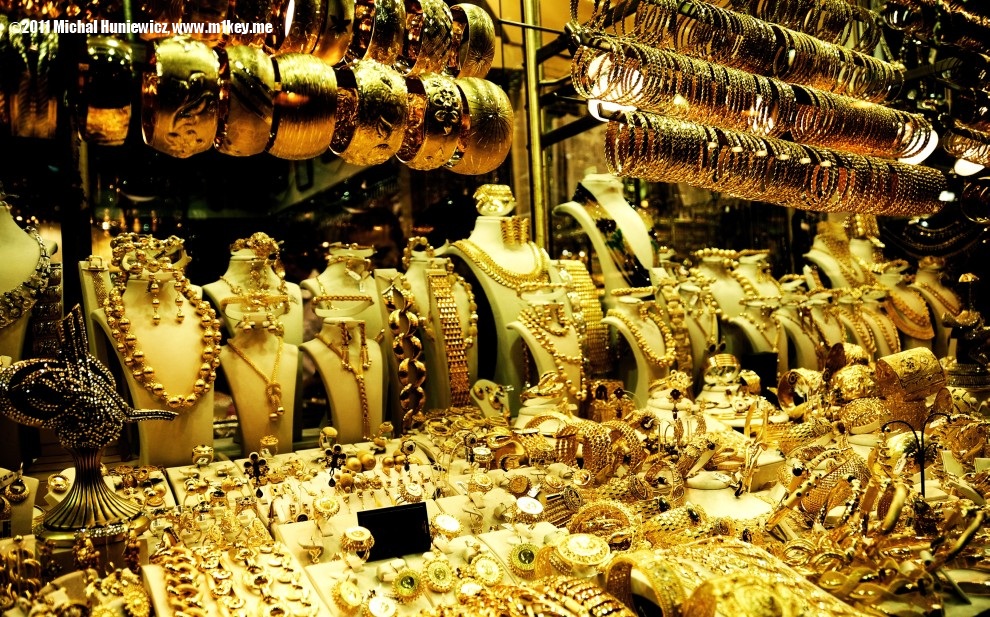
And useless items from the Grand Bazaar.
Cats in Istanbul
Cats in Istanbul

Cats occupy the streets of Istanbul, they are everywhere. They don't exactly trust people, they often keep their distance, unless,
like this one, they are too lazy to do so. I saw drivers almost deliberately driving into them, in poorer neighbourhoods.
The Bosphorus Bridge
The Bosphorus Bridge

I had never seen flags hanging from bridges before. Well, Turkey has some. Article 301 of the Turkish penal code says that for
publicly denigrating the Turkish nation or the Republic of Turkey one can go to jail for 6 to 24 months. This law was used against
Orhan Pamuk.
Warship
Warship

Turkey became a member of NATO in 1952. In 2010 it had world's 15th largest military expenditure - spending more than
Canada or Israel, but less than Germany or Japan.
What you can see in the picture is probably a Yavuz class frigate, designed in Germany. There are four of them - two were built in Germany,
two (including this one) in Turkey with German assistance. Its speed is 27 knots and its range 7,000 km.
Between Europe and Asia
Between Europe and Asia

"This waterway that passes through the centre of the city is not to be confused with the canals of Amsterdam or Venice or the rivers that divide Paris
and Rome in two: strong currents run through the Bosphorus, its surface is always ruffled by wind and waves, and its waters are deep and dark." - Orhan Pamuk.
Here, people are seen on a ferry that crosses the Bospohorus, going between Eminönü and Üsküdar. It's used by many people daily to get to work
and the ticket costs the same as a single tram ticket (2TL).
Asian side
Asian side
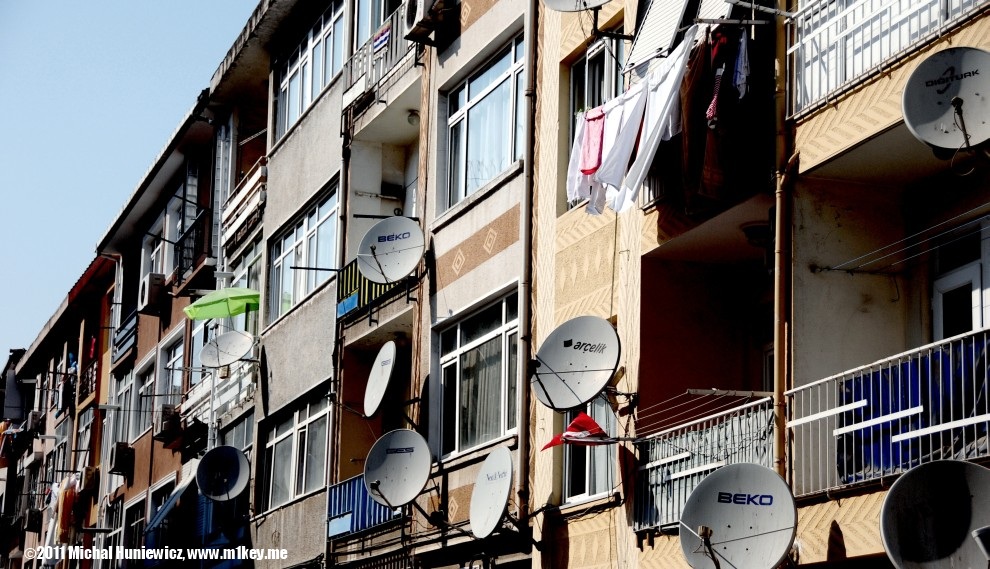
This reminds me of Poland. Ugly blocks of flats and a myriad of satellite dishes.
Bazaar on the Asian side
Bazaar on the Asian side

Here, a market on the Asian side of Istanbul is seen.
Bazaar on the Asian side
Bazaar on the Asian side

Same place.
Cemetery on the Asian side
Cemetery on the Asian side

I took this picture on the Asian side of Istanbul.
The muslim tradition forbids excessive reactions to people's death. Relatives are supposed to remain calm and patient. The deceased should be buried
as soon as possible, which is similar to the Jewish tradition. During burial, only men accompany the body to the actual burial site.
The dead are buried without coffins (unless it's prohibited by the law - in the UK certain cemeteries actually allow this), on their right side, facing Mecca.
Asian side
Asian side

"The crumbling fountains that haven't worked for centuries, the poor quarters with their forgotten mosques,
the sudden crowds of schoolchildren in black smocks with white collars, [...] the little grocery stores darkened
by age, dust and lack of custom [...]" - Orhan Pamuk describing Istanbul poorer neighbourhoods.
Fact: About 4.4 million people live on the Asian side of Istanbul and 1.3 million travel daily to Europe.
Vegetables
Vegetables
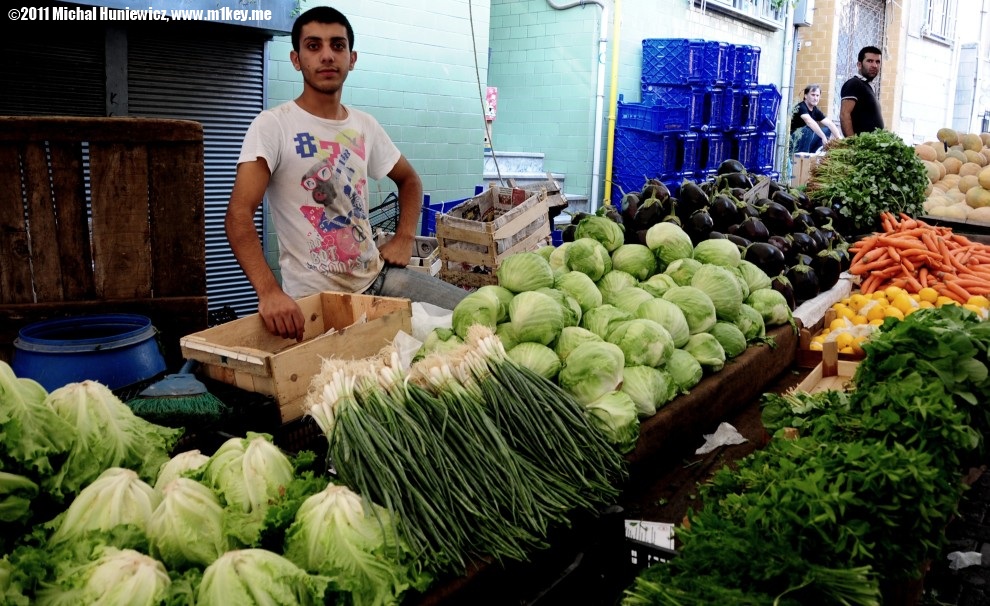
An average Turkish person consumes a pretty large amount of vegetables. Vegetables are cooked in olive oil
or fried; they are often eaten with yoghurt sauce. Cacık is one of the famous yoghurt and vegetable based
dish.
Roofed market
Roofed market

In this picture you can see that the market is roofed - the roof isn't made of bricks though, it's just some sort of canvas-like
material.
Hole in a wall
Hole in a wall

Not every building is well taken care of. This photo shows a small door leading to an inner courtyard of an old building, somewhere in the Eminönü
neighbourhood. Eminönü was in the heart of the early Constantinople; and today it's still one of the main touristic areas of Istanbul - this is where
the main bazaars are, as well as the major mosques.
"Many Western writers and travellers find this charming. But for the city's more sensitive and attuned residents, these ruins are reminders
that the present city is so poor and confused that it can never again dream of rising to the same heights of wealth, power and culture." - Orhan Pamuk.
Turkish gentlemen
Turkish gentlemen

I met those two men on the Asian side of Istanbul. They couldn't say a word in English but said a lot of words in Turkish, which in turn
I couldn't understand, except for two: Yugoslavia and güle güle. The latter means bye bye. I have no idea why he said Yugoslavia though.
The average life expectancy in Turkey is 72 for men and 77 for women, and has been steadily going up.
In the mosque
In the mosque

Children playing in the Blue Mosque.












































